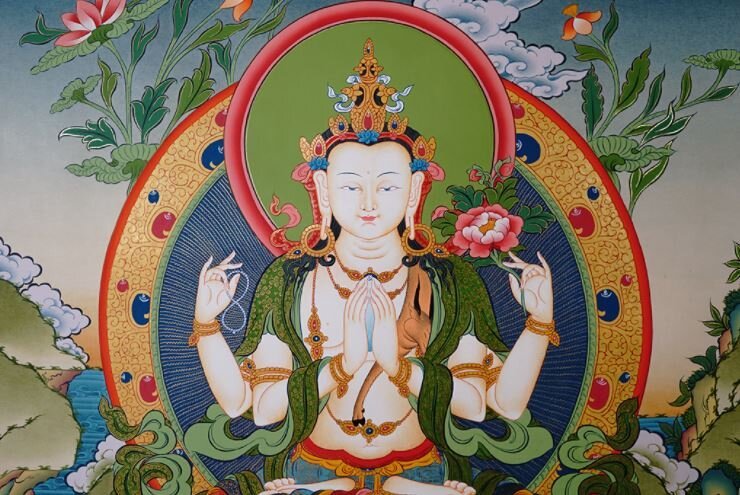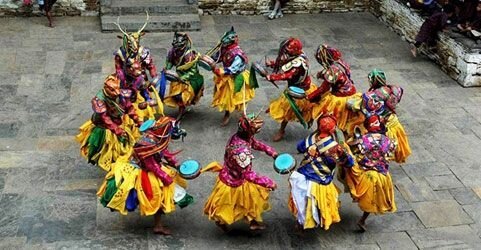Buddhist Art Of Sikkim
Sikkimese folk music and dances are ingrained in the culture. The majority of tribal dances reflect the harvest season and are performed for good fortune. Sikkim is a unique combination of diverse cultures' customs, religions, and traditions. Sikkim has been occupied by three tribes from ancient times: the Lepchas, the Bhutias, and the Nepalese. Even now, they continue to shape the culture of Sikkim's people.
Buddhist art in Sikkim
Thangka Painting:
Buddhist art dates back to the 7th century which spread across the entire region. The most popular of these is the thangka painting. In Sikkim, you may see thangka painting and the various creative traditions that go with it all over the place. These cover a wide range of interfaces. They may be found in two-dimensional wall paintings, three-dimensional woodcraft, mask creation, and architecture. Initially, these paintings were the sole medium available for preaching Buddhism's greatest principles. The majority of 'Thangkas' are composed of cotton canvas with a silk frame. These paintings depict representations of many Buddhist Gods, Goddesses, and ideologies.
Paintings were first created by priests and monks, and the talents were eventually passed down from generation to generation. Today, monasteries and practitioners benefit from the commercialization of this art. These paintings are done directly on earthen walls that have been given a smooth layer of gypsum or white clay on the surface. Buddhist murals use the same motifs as thangka painting but on a much bigger scale.
A wall gives the artist more room to explore a topic than a thangka's small surface. Murals with a narrative flow, especially those found in monasteries, are common. The Namgyal Institute of Tibetology in Gangtok, Sikkim, has a secular application of the same art. The institute is built in traditional Tibetan architecture and serves as a major center for Tibetan studies.
Carving in Wood:
Sikkim's wood carvings are a hallmark of India's real art. Wood carving is a distinct art form that is used to create ceremonial items, furniture, and architecture. Symbols and icons carved in wood may be seen on monasteries and structures across Sikkim. Religious symbolism is frequently seen in carved items. Sikkim's mask dance is also shown in wood sculptures. Outstanding masks made of wood and paper-mâché are available in Sikkim. The carved wooden sculptures and wood carvings of Pemayangtse Monastery are exquisite. The wood and plaster detailing seen between the walls and ceilings of Buddhist monasteries are similar to that found in thangkas.
Weaving a Carpet:
Weaving in Sikkimese is perhaps the oldest type of carpet weaving in the world. Expert carpet weavers are reported to be among the Bhutia community's women. A-frame loom is required for the conventional weaving design. The intricate weaving techniques used by Sikkim's hardworking craftsmen may be seen in the designs of stunning carpets.
Handicrafts:
The Sikkimese weave a variety of eye-catching motifs and patterns. Their expertise in the technique is reflected in the woolen blankets, purses, shawls, and jackets they create. Sikkim's further specialties include 'thangkas' (traditional tapestries), leather works, dolls, colorful appliqué work, batiks, a good variety of dolls, and a range of stylish clothing. The government has formed a cottage industries institution to nurture and promote such businesses, where local handicrafts are available for purchase here.
Sikkim Fairs and Festivals:
Sikkim is a state in northeast Asia that hosts a variety of festivals throughout the year. As Buddhism is practiced by the majority of the people in Sikkim, the festivals celebrated here are linked with Buddhism and are observed with great pomp according to the Buddhist calendar.
The majority of Sikkim's festivals are held at Gompas or Monasteries, where people assemble to commemorate the event. Sikkim's citizens participate in colorful and energetic dances and music during these festivals.
Sikkim occupies a unique position in the Indian Union due to its rich and distinct culture and heritage. It is a location where many ethnic communities live in perfect peace with their cultures, religions, traditions, and customs, resulting in Sikkim's art not only being distinct but also a perfect synthesis of the history and tradition of diverse ethnic communities.





